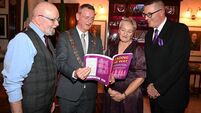Julie Helen: 'Making information accessible makes me light up'

"I am particularly tuned in to how we formulate information because I have been working with plain English and easy-to-read formats for years," writes Julie.
I feel fortunate to have a lot of journalists in my life. A masters gave me that- a connection to a craft I am very proud of. People close to me often remark on how quickly and effectively I can put information together and I must say I get a great buzz from doing it.
I love how words form and how we can get our messages across to each other. Making information accessible to many people, using different formats and using my skills to support others just make me light up from the inside out.
I think if I heard someone say that I was an excellent communicator, it would be the ultimate compliment anyone could pay me.
Most of my communications expertise has been nurtured in the disability sector and for me, good communication preserves the dignity of every individual and that is a powerful quest to be on.
I know many good communicators who find reading and writing a challenge and effective communication is often about working in partnership or striking a deal with each other even when we may broker the flow in mere seconds or in one message.
Our ways of communicating change. We have different tools and points of emphasis.
I know in some style guides for articles in print, the exclamation mark is now discouraged. The decision has stemmed from overuse, particularly on social media platforms and so the impact of the line and the dot has lost some impact. In professional circles, in emails and in comments I feel like using an exclamation mark has become an act of passive aggression and removing the mark and asking people to be a bit more direct without the implication of “I’m better than you” or “like I have told you before” might serve us all well.
Not too long ago I received an email that included more exclamation marks than I could count, it had words in all capitals telling me what MUST be done and had other words underlined and in bold type. It was all the bells and whistles of the worst type of communication I could receive. I immediately felt like I had to defend myself.
The email itself was couched as a recap of a meeting but due to all the visual changes, the tone entirely transformed from one of making plans to making me feel like I wasn’t doing a good job. It was way too long as well, which added insult to injury.
Behind the offensive email, I am pretty sure the person didn’t mean any harm or disrespect. In fact the way the same person communicated in person and by email were like opposite ends of a spectrum.
I am particularly tuned in to how we formulate information because I have been working with plain English and easy-to-read formats for years. They have given me the gift of saying what I mean in a simple and straightforward way. Doing that takes away any doubt but also commands a respect for the words that are on the page. Headings are in bold font, nothing else. Capital letters do not live in the middle of sentences and nothing is underlined because doing so can make a word more difficult to read for some people.
In easy-to-read format, the way to signal something is especially important is to tell the reader it is important in the sentence before or after the information itself or use an image to go with the text that tells the reader how important it is. Those straightforward formats work so well and all dignity and respect remain intact.







 App?
App?


